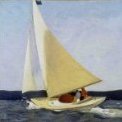-
Posts
866 -
Joined
-
Last visited
Reputation Activity
-
 Stockholm tar reacted to wefalck in "Scottish Maid" stern structure
Stockholm tar reacted to wefalck in "Scottish Maid" stern structure
SCOTTISH MAID seems to have been one of the first 'clipper' style schooners with a closed gallion and very sharp lines for and aft. The fine lines mean that she wouldn't have had a lot of buyonancy there, resulting her dipping deep in when the sea was heavy. So it may have been vital to make provisions for shedding water fast, so that she would rise fast out of any waves. Partially open bulwarks seem to have been quite common (on smaller vessels) before swinging ports were introduced.
A vaguely remember having seen the half-model of her in the museum in Aberdeen some 15 years ago.
wefalck
-
 Stockholm tar got a reaction from egkb in HMC Sherbourne 1763 by Hollander-jan - Caldercraft - 1/64
Stockholm tar got a reaction from egkb in HMC Sherbourne 1763 by Hollander-jan - Caldercraft - 1/64
Hi Jan,
I've just caught up with your log. Good work with your clinker planking, and I think you've found it's not so difficult. Believe me, I felt the same before doing mine, and as I think you've found, it is manageable. If I have a small criticism, it is that I think you might have overlapped the planks perhaps a little more, and you have to keep an eye on the tapering. All in all though very well done.
I think you've also learnt that it's better to progress at a slower pace, trying to make each part as best you can, rather than hurrying to get to a perhaps more enjoyable part of the build. Trying I know, but you'll end up with a better model as a result. Tony also hit the nail on the head when he said that we are our own worst critics!
I see you've made up one of the guns. Good idea for checking those gunport heights – I wish I had thought of doing that, since my larboard bulwark was a little too low at the stern. It isn't noticeable, but let's just say the two after guns needed some serious modification to fit – and even then they just cleared the upper edge of the port! You might want to think about shortening the trunnions, they're the metal pins the gun rests on on the carriage, as they shouldn't overlap the carriage sides. A small file should do it.
Look forward to seeing what's next.
-
 Stockholm tar reacted to Hollander-jan in HMC Sherbourne 1763 by Hollander-jan - Caldercraft - 1/64
Stockholm tar reacted to Hollander-jan in HMC Sherbourne 1763 by Hollander-jan - Caldercraft - 1/64
More of the same planking I mean. Clinker planking is more difficult than I thought but it is going the way I want, although it is a hell of a job.
I am doing the best I can and even more some time I surprise my self and learning in the process.
I have to slow down myself before I make mistakes that will cost me. On the other hand I can not wait to work on the deck or other things, but for now I will slow down a bit before it is to late. I think this slowing down is one off the things I learn from this hobby.
Have solved the bulkwark problem by closing two gunports and opening two other ones. in time I will see if that is enough to overcome my mistake.
Enjoying this whole thing of building a boat very much.
Jan
-
 Stockholm tar got a reaction from WackoWolf in Zheng He Treasure Ship Kit
Stockholm tar got a reaction from WackoWolf in Zheng He Treasure Ship Kit
Those Chinese 8 year olds must be pretty advanced – and I would think many here will find it interesting to build when they're sixty eight!
-
 Stockholm tar reacted to Jeff-E in HMS Victory by Jeff-E - FINISHED - Panart - 1:78 Scale - Bow Section
Stockholm tar reacted to Jeff-E in HMS Victory by Jeff-E - FINISHED - Panart - 1:78 Scale - Bow Section
Hi All,
I have made a bit more progress today. I have coppered a few more strakes on the port side only 2 to go till I reach my gore line on that side. I also came across a better method of making the plates fit when you come to cutting the angles where they meet the stem or the battern.
It is in one of Keith Julier's books and he says to lay the plates but as they reach a point where they need to be cut , cut a full plate to fit the angle and the fill the gap behind it with a half or three quarter plate. It saves trying to cut very small triangular shapes some of which on my hull are only 2 or 3mm long and trying to trim them to make them fit neatly.
I did skim through this article but did not quite understand what he meant but I do now and although I will plate the starbord side to match the port side I will be using this method from here on in.
I have also fitted the last 2 beakhead deck frames and started to paint the area behind them and the gunports
A note to anyone else building model if you do intend to paint it paint the space between the middle and upper wale at the bow BEFORE fittng the beakhead deck frames as this area is a bit hard to access after they are fitted. I should heed my own advice, I said in my last update that these areas will be difficult to get at
A couple of pic's of the gunports, this is only the first coat
Last of all I would like to ask your opinion of the colour for in between the wales.The first pic shows the colour as it is at the moment, this is Tamiya flat yellow, I think it is a bit bright. I am thinking of using yellow ochre, I think it is by Mantua, which is on the stick in the second pic. It is the same colour as I painted the test gun carriges
I would order some yellow ochre from Caldercraft or Admiralty paints but the only supplier I know of in Australia, Minature Steam, is out of stock
-
 Stockholm tar reacted to Jeff-E in HMS Victory by Jeff-E - FINISHED - Panart - 1:78 Scale - Bow Section
Stockholm tar reacted to Jeff-E in HMS Victory by Jeff-E - FINISHED - Panart - 1:78 Scale - Bow Section
Hi All,
A little more progress, all the lower strakes of each wale is now fitted and I have started to make the second strake for each of the three lower wales these should be fairly straight forward to fit as they just lay on top of the strake below.
I have also done some more copper plating on both sides.
While browsing the forum the other night I came across a jig by GTM in the 'wooden tips and tricks and making jigs' section for making eye pins as I had been thinking about how I was going to make some very small hooks for my cannon rigging I thought it was a great idea and that maybe I could use it for making hooks for the tackle on my cannons.
So I made the jig up out of a piece of dowel, he used brass rod which will be much more durable, but I don't have any on hand and it works a treat. Thankyou very much GTM I can make a hook out of 0.3mm wire 2mm long in about 2 minutes.
I will give a brief description how I made mine but for a full description go to the page mentioned above, first I dilled a 0.85mm in the end of the dowel close to the edge about 12mm deep, then I filed a flat on the dowel about 4mm in from the end until half of the previosly drilled hole was exposed a slot was then cut on one side of the hole so that the eye of the hook can be inserted into it so it will stay in line with the bite of the hook.
To use the jig I inserted a 0.75mm drill bit backwards in my pin vice and lay the wire onto the jig and push the drill bit into the hole, trapping the wire in the half hole, then it just a matter of bringing the tag end of the wire over to meet the main piece and you have a eye formed.
Remove from the jig and then lay the eye into the slot insert the drill bit into the hole again and bend the wire around until you form a hook, remove it from the jig and trim up
The finished product
As I have about 100 of these to make I would like to thank GTM for his time saving and brilliant Idea.
Sorry if some of the pics are a bit blury but the light was a bit dull even with the flash
-
 Stockholm tar reacted to flying_dutchman2 in Colored thread for rigging
Stockholm tar reacted to flying_dutchman2 in Colored thread for rigging
Thank you for the suggestions and they are a great help. Will do the dark colors and the running rigging a shade of tan. Makes sense that the running rigging is un-tarred as that would clog the blocks.
Marc
-
 Stockholm tar got a reaction from flying_dutchman2 in Colored thread for rigging
Stockholm tar got a reaction from flying_dutchman2 in Colored thread for rigging
Hi Marc.
Historically rigging was not all of the same colour, nor does it depend on its being horizontal or vertical. Ships of various nationalities also more or less followed the same practice:
Standing rigging, which supported masts and yards, was tarred for protection from the elements. This means that it was black or a dark colour, although many modellers prefer to use dark grey or brown to make give it a weathered look.
Running rigging, which moves and runs through blocks, was left untarred and is thus hemp or tan coloured. This can vary between light and dark shades, although it's best not to make it too light.
One perhaps problematic area is the ratlines on the shrouds. Are they standing or running rigging? There are various views on this. My view is that although they were fixed, ie. like standing rigging, they weren't tarred but left natural, or given a light coating of thin preservative. There were likely two main reasons for this: the men's feet wouldn't get tar on them (and it would thus be tranferred elsewhere); the ratlines broke frequently and were continually being replaced.
-
 Stockholm tar got a reaction from Q A's Revenge in Colored thread for rigging
Stockholm tar got a reaction from Q A's Revenge in Colored thread for rigging
Hi Marc.
Historically rigging was not all of the same colour, nor does it depend on its being horizontal or vertical. Ships of various nationalities also more or less followed the same practice:
Standing rigging, which supported masts and yards, was tarred for protection from the elements. This means that it was black or a dark colour, although many modellers prefer to use dark grey or brown to make give it a weathered look.
Running rigging, which moves and runs through blocks, was left untarred and is thus hemp or tan coloured. This can vary between light and dark shades, although it's best not to make it too light.
One perhaps problematic area is the ratlines on the shrouds. Are they standing or running rigging? There are various views on this. My view is that although they were fixed, ie. like standing rigging, they weren't tarred but left natural, or given a light coating of thin preservative. There were likely two main reasons for this: the men's feet wouldn't get tar on them (and it would thus be tranferred elsewhere); the ratlines broke frequently and were continually being replaced.
-
 Stockholm tar reacted to Jeff-E in HMS Victory by Jeff-E - FINISHED - Panart - 1:78 Scale - Bow Section
Stockholm tar reacted to Jeff-E in HMS Victory by Jeff-E - FINISHED - Panart - 1:78 Scale - Bow Section
Hi All,
I have made a little bit of progress today I have attached the lower wale strakes above the waterline and shaped the lower strakes for the other 2 wales. Because I had no way of clamping them to the hull while the glue dried I drilled and pinned the strakes with brass nails which were later removed and bamboo treenails fitted into the holes these will be sanded flush with the wale and as the hull will be painted they will not be seen.
I am going to fit the lowwer strake of each wale first to get them even and lined up properly with the ports and then the next strake will be easy as it only has to fit up against the one below it
I also got a few more copper plates laid
-
 Stockholm tar got a reaction from Jeff-E in HMS Victory by Jeff-E - FINISHED - Panart - 1:78 Scale - Bow Section
Stockholm tar got a reaction from Jeff-E in HMS Victory by Jeff-E - FINISHED - Panart - 1:78 Scale - Bow Section
Jeff,
Can't help with the copper plate cutting problem, but she's looking good! Great work!
-
 Stockholm tar reacted to Jeff-E in HMS Victory by Jeff-E - FINISHED - Panart - 1:78 Scale - Bow Section
Stockholm tar reacted to Jeff-E in HMS Victory by Jeff-E - FINISHED - Panart - 1:78 Scale - Bow Section
Hi All,
I have fitted the batterns to follow the previosly marked waterline, you may also notice that I have also adde the top wale and I'm in the process of bending the rest of them. These will be fitted over the next few days
I have also started to lay the copper plates on the port side.
I discovered that cutting these plates is a horrid job, the method I'm using is to try and hold them down on a self healing cutting mat wtih a steel rule and cut them with a stanely knife, but it tends to grab the plate and slide it out from between the ruler and the mat and when I can hold the plate tight the knife only seems to score the plate not cut it. I don't know if it's the plates in this kit or I'm using the wrong techniquie to cut them.
I know I can't use scissors or cutters to cut them as they distort the plates to much and they do not give a clean cut.
The angled plates in the above pics was achiieved by filing them down and the last on on the top row I managed to score a line deep enough to hold in the jaws of a pair of pliers and bend it a couple of times till it snapped off.
Any suggestions or advice on cutting these plates woud be gratly appreciated
-
 Stockholm tar reacted to Jeff-E in HMS Victory by Jeff-E - FINISHED - Panart - 1:78 Scale - Bow Section
Stockholm tar reacted to Jeff-E in HMS Victory by Jeff-E - FINISHED - Panart - 1:78 Scale - Bow Section
Hi All,
Another small udate. after making a water line marking jig, pics below.
I marked the water line onto the hull at the distance stated in the plans which is 70 mm from the bottom of the hull which is to me seems a strange way of doing ti as all the other measurements are taken from the bottom of the keel
I set the hull up in my keel clamping vice with the bottom of the hull firmly against the steel top plates and then made sure the hull was level fore and aft and athwart ships then I dedcuted the keel length from the bottom of the hull from the distance from the top of the vice to the table, added 70mm to this and checked it on both rules to make sure the hull was even on the table
I then marked the water line on both sides of the hull
I also marked the position of the wales using the jig , bearing in mind that the lines for the wales are a guide only and the wales will follow the line of gunports
I have run into a slight problem and have been trying to overcome it this afternoon and that is how to mark a gore line for the copper plateing, as it is only a bow section I don't have a centre of a ship to go off,but i have been looking at some logs and Longridge has a nice plan of the coppering in his book.But any suggestions on how to go about it would be most welcome.
My lastest idea is to come down about 7 or 8 tiles form the keel at the back and then lay a plank along that line and see how it looks . I think it might be a case of trial and hopefully not to many errors
I would also like to take this opportunity to wish all of you a very Merry Christmas
-
 Stockholm tar got a reaction from egkb in Before I spend the money.
Stockholm tar got a reaction from egkb in Before I spend the money.
Patrick,
It might just be that many modellers don't think she looks interesting enough, although she would seem to be on a par with their other smaller kits. That shouldn't put you off however, and if you want to have a go at it, why not? Perhaps you can be the first on MSW with a build log, and perhaps start a trend? After all, the Sherbourne now has a dedicated following.
If you have look at Jotika's website you'll see that there are couple of favourable reviews from people who have built it, along with a few pics.
Don't get too hung up on the phrase 'Nelson's Navy'. It's a catch-all expression which is designed to appeal to prospective purchasers, etc. Nelson probably never saw some of the ships themselves. I am a member of a dedicated Nelson website, where one of the other members is heartily sick of the term!
-
 Stockholm tar reacted to Jeff-E in HMS Victory by Jeff-E - FINISHED - Panart - 1:78 Scale - Bow Section
Stockholm tar reacted to Jeff-E in HMS Victory by Jeff-E - FINISHED - Panart - 1:78 Scale - Bow Section
Hi All,
A bit longer than I expected, due to work issues but the stem planking is complete and sanded.The two holes drilled at the front edge of the stem are for the bobstays, I was going to drill the hole for the mainmast stay collar but seeing as there wont be one fitted I omitted it
Some pics follow
The next job is to mark the water line and the position of the wales and then to make and fit the wales
-
 Stockholm tar reacted to AntonyUK in HMS Victory by AntonyUK - FINISHED - Scale 1:36 - cross-section
Stockholm tar reacted to AntonyUK in HMS Victory by AntonyUK - FINISHED - Scale 1:36 - cross-section
Hello Shipmates.
Another update on my progress.
Main Gun Deck is now fixed into place with no errors
Started to plank the Deck with Tulip wood. Very nice looking wood.
Deck now fixed onto the bulwarks with knees fitted.
Photo looking up at the deck from the underside.
All the planks cut to length and drilled at ends only for treenails.
Waterways in and now ready to plank..
First planks laid.
Will post another update when Gun Deck is complete.
Thanks for looking in.
Regards Antony.
-
 Stockholm tar reacted to Gregor in HMC Sherbourne 1763 by Gregor – FINISHED - Caldercraft – Scale 1:64 - first build
Stockholm tar reacted to Gregor in HMC Sherbourne 1763 by Gregor – FINISHED - Caldercraft – Scale 1:64 - first build
Thanks, Jay, Kester and Tony for the kind words, and good health to you all.
I'm really enjoying how every Sherbourne builder makes his or her own choice of how far he or she will go to get nearer to the no longer existing and somewhat elusive original (Jay's decision to build a Sherbourne from scratch is the ultimate consequence of this quest).
For me the kit provides a solid beginners platform which can be altered or improved individually to an astonishing degree, as you and other builders here demonstrate.
With the best wishes,
Gregor
-
 Stockholm tar got a reaction from Jay 1 in HMC Sherbourne 1763 by Gregor – FINISHED - Caldercraft – Scale 1:64 - first build
Stockholm tar got a reaction from Jay 1 in HMC Sherbourne 1763 by Gregor – FINISHED - Caldercraft – Scale 1:64 - first build
Jay,
Thanks, I'm more-or-less back in the land of the living, and hoping to get back to my Sherbourne soon, other things – wife, cats, Christmas, etc., permitting!
Glad you liked my log on the rigging, and as said another should be up soon. Just finishing it off and a couple of pics to take.
It will be interesting to see to see how your draughts turn out, with the help of the drawings from the NMM. I'll bet it's quite a bit different from the kit – and I'll probably be continually saying, 'Now why didn't think of that?'
-
 Stockholm tar reacted to Jay 1 in HMC Sherbourne 1763 by Gregor – FINISHED - Caldercraft – Scale 1:64 - first build
Stockholm tar reacted to Jay 1 in HMC Sherbourne 1763 by Gregor – FINISHED - Caldercraft – Scale 1:64 - first build
Gregor, your bowsprit looks wonderful--excellent work! Likewise, your soldering work looks very nice and your catheads look great!
Kester, I hope you're feeling much better (I thoroughly enjoyed reading your post on rigging your Sherbourne )!
Tony, looking forward to your next update and seeing what you come up with for doing your blocks--I know it'll be another great innovative solution!
Must report that my recent work in my Sherbourne yard doesn't make for very exciting posts for the time being. Additional plans from the NMM recently arrived, so am back to slowly re-drafting the draughts (my drawings are still a bunch of horizontal and vertical lines at present); likewise, I have some research coming that may hopefully shed some light on a couple of issues.
It's always a treat to see how everyone's builds are progressing and yours is looking very crisp and sharp, Gregor! Again, well done on your recent work--I like it very much!
Cheers,
Jay
-
 Stockholm tar got a reaction from Jay 1 in HMC Sherbourne 1763 by Gregor – FINISHED - Caldercraft – Scale 1:64 - first build
Stockholm tar got a reaction from Jay 1 in HMC Sherbourne 1763 by Gregor – FINISHED - Caldercraft – Scale 1:64 - first build
Gregor,
Really good work on your Sherbourne, she looks magnificent. Nice job on the research front too, and I especially like your windlass. I went with the original idea, but made my own better-shaped one.
Yes, you're right, it is rather quiet on the Sherbourne yards at the moment. I'm afraid work on mine has come to a temporary halt, as I'm just getting over a rather bad cold. I'm feeling better now, and hope to be making another post soon.
Looking forward to seeing more.
-
 Stockholm tar got a reaction from egkb in HMC Sherbourne 1763 by Gregor – FINISHED - Caldercraft – Scale 1:64 - first build
Stockholm tar got a reaction from egkb in HMC Sherbourne 1763 by Gregor – FINISHED - Caldercraft – Scale 1:64 - first build
Gregor,
Really good work on your Sherbourne, she looks magnificent. Nice job on the research front too, and I especially like your windlass. I went with the original idea, but made my own better-shaped one.
Yes, you're right, it is rather quiet on the Sherbourne yards at the moment. I'm afraid work on mine has come to a temporary halt, as I'm just getting over a rather bad cold. I'm feeling better now, and hope to be making another post soon.
Looking forward to seeing more.
-
 Stockholm tar reacted to Gregor in HMC Sherbourne 1763 by Gregor – FINISHED - Caldercraft – Scale 1:64 - first build
Stockholm tar reacted to Gregor in HMC Sherbourne 1763 by Gregor – FINISHED - Caldercraft – Scale 1:64 - first build
It’s rather quiet in the Sherbourne yards at the moment, certainly it was in mine. Over the last few weeks I took tiny steps towards the bowsprit. A lot of small things hat to be finished (the rail, catheads, stairs) first.
I used the dowel provided in the kit, but added a piece of square wood at the rear end (a cheap thing I found in a local hardware store – too soft and too easy to bend to use as bowsprit) with a small round dowel glued inside for stability. The tapering was made by hand. Adding a piece of wood was no problem because I wanted to paint masts and spars anyway, so several layers of yellow ochre cover up nicely.
The bowsprit support was made with the parts provided in the kit. I cut away the “connecting pieces” and added two holes for the iron strongback and the retaining fid (1mm square brass rod).
To complete the bowsprit assembly I finally had to learn soldering. The iron hoop, the cranes iron and traveller were made with copper strips and eyelets. I had to remove a lot of molten pieces before shooting these pictures…
Cheers to all,
Gregor
-
 Stockholm tar reacted to Gregor in HMC Sherbourne 1763 by Gregor – FINISHED - Caldercraft – Scale 1:64 - first build
Stockholm tar reacted to Gregor in HMC Sherbourne 1763 by Gregor – FINISHED - Caldercraft – Scale 1:64 - first build
Tony’s update motivates me to make a picture of my interpretation of the shot racks, made from 4mm spare wood strips, sanded down to 3mm to follow the curve of the deck. Even using a stand for my proxxon mini drill, getting a centre line and even spacing proofed very difficult to achieve (at least I tried).
Also, I drilled my holes too deep, so that the balls almost disappeared in them. I had to fill the holes with toy clay before inserting the balls in the holes. There is a metal band (black paper), giving more strength, and two 0.3 eyelets in each for the gun tackles.
I used a paper template to find the spots for drilling around the gun ports. Each has now two holes for the breeching ropes and two for eyelets to make fast the lanyards from the (planned) gun port lids.
I have finally decided not to make a deckhouse – I shortened the sliding hatch I made earlier following Tony’s tutorial to the proportions shown in the NMM plans and glued it to the correct position.
I was a little disappointed when I belatedly realised that my planking pattern does not fit the positions of the main hatch, scuttles and mast, which are cutting through the deck beams. Now I understand why and how Dirk has made his deck plan (another lesson learned …).
Cheers,
Gregor
-
 Stockholm tar reacted to Gregor in HMC Sherbourne 1763 by Gregor – FINISHED - Caldercraft – Scale 1:64 - first build
Stockholm tar reacted to Gregor in HMC Sherbourne 1763 by Gregor – FINISHED - Caldercraft – Scale 1:64 - first build
Phase one of deck planking done: After admiring many beautiful examples and experimenting on paper with various plank lengths and shifts I always came back to Tony’s 12 cm, 3 shift pattern. I think it’s adequate when using the 4 mm strips provided with the kit. Shorter planks and more than 3 shifts provided very strange patterns, not at all aesthetically pleasing.
Learning from Tony’s experience, I struggled with the symmetry of my hull, which I neglected in the early days of enthusiastically gluing together bulkheads, keel and false deck.
That’s why I didn’t cut out the holes for the scuttles behind the main hatch (I will have to paint the planks black under the gratings). I also had to bend the planks laterally to achieve the impression of a symmetry that is not there. One can hardly detect it, but it was a struggle, working with dividers, paper strips etc.
For the caulking I used the black pencil method. The strips in the kit had to be sanded heavily; their edges were very rough. Because of my impatience the planks are not always of the same width …
The finishing is not what I wanted to achieve: After scraping the planks with a sharp blade and sanding I used linseed oil again. It highlights the structure of wood, but here this effect was not what I wished for (it shows also pencil dust rubbed in while sanding). Again, as on the hull, I will have to learn to select the wooden strips very carefully or even be prepared to replace them.
It seems my crew did not religiously holystone the deck and flogging it dry every day before sunrise, and my deck has the worn look of twenty years of honourable service.
To console myself I finished the deckhouse. Now my CO has a place to hide when somebody makes unfriendly comments about the state of the deck.
I will adapt the gratings to the deck and do other small things while thinking hard about treenailing methods. I already tested the hot syringe needle and nearly destroyed my deck (it looks exactly like it sounds: spots of burnt wood). I will try to “heal” it with the toothpick method.
Gregor
-
 Stockholm tar reacted to Gregor in HMC Sherbourne 1763 by Gregor – FINISHED - Caldercraft – Scale 1:64 - first build
Stockholm tar reacted to Gregor in HMC Sherbourne 1763 by Gregor – FINISHED - Caldercraft – Scale 1:64 - first build
The plan helped to shape the new stern and its rail, and with the positioning if the steps.
I’m still puzzled about the position of the hatch, and it’s form. The plan shows (in a fine red line) a structure like the one on Kesters Sherbourne, the deck plan suggests a sliding hatch, leading to stairs to the “Great Cabbin”.
I made my hatch, covered with black painted “metal sheets”, as Tony discussed in one of his postings; it is lower than on the plan (where it is as high as the bulwarks) to avoid a conflict with the tiller (which I altered slightly). Sadly, the tiller is not shown on the Sherbourne plans.
It is probably not the last version.








